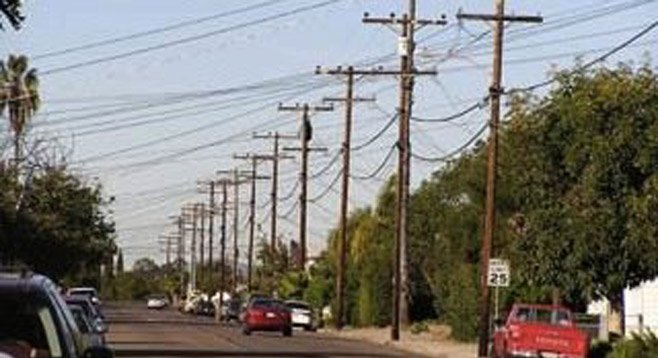 Facebook
Facebook
 X
X
 Instagram
Instagram
 TikTok
TikTok
 Youtube
Youtube

Thanks to the grassroots efforts of the Kensington/Talmadge Planning Group and its undergrounding subcommittee, the City of San Diego’s Land Use and Housing Committee unanimously voted on October 23 to create the Utility Underground Advisory Group. Every neighborhood in the city is expected to benefit.
The City of San Diego has been burying electrical transmission lines in neighborhoods since 1970. Approximately three years ago, one community in each of the then-eight council districts was selected for individual undergrounding projects. In the case of (former) District 3, the community of Talmadge was selected. The city assigned low-bid contractors to seven communities while it assumed the undergrounding responsibilities for Mission Hills.
Once work was under way, it reputedly became apparent that there were no standardized procedures for undergrounding. Some contractors handled this lack of uniformity worse than others. (The city’s efforts in Mission Hills were generally well received by the residents.)
Talmadge residents recognized the problems when they arrived home from work to find their streets dotted with green utility boxes. Worse, some owners were greeted by more than one box placed on the easement property between the street and sidewalk.
Undergrounding was interpreted to mean that telephone poles and utility wires would vanish from sight, “underground.” Not so. Unsightly “above-ground” utility boxes were became a blight to the neighborhood. Property values were compromised.
Anguished residents voiced their displeasure to the Kensington/Talmadge Planning Group. As a result, an undergrounding subcommittee was formed to investigate and champion “under-the-ground” utilities. Other disenchanted communities were expressing similar objections to their city-council reps.
The Kensington/Talmadge Planning Group, in order to protect their community’s historic character, voted for an undergrounding moratorium until standardized procedures could be implemented.
Chairman David Moty then introduced the community group’s objections to the central Community Planning Committee chaired by Joe La Cava. All community planning groups then joined together to demand a task force. Their collective voice culminated in the creation of the Utility Underground Advisory Group, with Joe La Cava serving as chair. The expected outcome is that all communities and neighborhoods will receive the same fair and equitable treatment.
The advisory group will be comprised of 14 people: selected residents, representatives from SDG&E, Cox Communications, AT&T, and city staff. Their work should be completed within one year.


Thanks to the grassroots efforts of the Kensington/Talmadge Planning Group and its undergrounding subcommittee, the City of San Diego’s Land Use and Housing Committee unanimously voted on October 23 to create the Utility Underground Advisory Group. Every neighborhood in the city is expected to benefit.
The City of San Diego has been burying electrical transmission lines in neighborhoods since 1970. Approximately three years ago, one community in each of the then-eight council districts was selected for individual undergrounding projects. In the case of (former) District 3, the community of Talmadge was selected. The city assigned low-bid contractors to seven communities while it assumed the undergrounding responsibilities for Mission Hills.
Once work was under way, it reputedly became apparent that there were no standardized procedures for undergrounding. Some contractors handled this lack of uniformity worse than others. (The city’s efforts in Mission Hills were generally well received by the residents.)
Talmadge residents recognized the problems when they arrived home from work to find their streets dotted with green utility boxes. Worse, some owners were greeted by more than one box placed on the easement property between the street and sidewalk.
Undergrounding was interpreted to mean that telephone poles and utility wires would vanish from sight, “underground.” Not so. Unsightly “above-ground” utility boxes were became a blight to the neighborhood. Property values were compromised.
Anguished residents voiced their displeasure to the Kensington/Talmadge Planning Group. As a result, an undergrounding subcommittee was formed to investigate and champion “under-the-ground” utilities. Other disenchanted communities were expressing similar objections to their city-council reps.
The Kensington/Talmadge Planning Group, in order to protect their community’s historic character, voted for an undergrounding moratorium until standardized procedures could be implemented.
Chairman David Moty then introduced the community group’s objections to the central Community Planning Committee chaired by Joe La Cava. All community planning groups then joined together to demand a task force. Their collective voice culminated in the creation of the Utility Underground Advisory Group, with Joe La Cava serving as chair. The expected outcome is that all communities and neighborhoods will receive the same fair and equitable treatment.
The advisory group will be comprised of 14 people: selected residents, representatives from SDG&E, Cox Communications, AT&T, and city staff. Their work should be completed within one year.
Comments